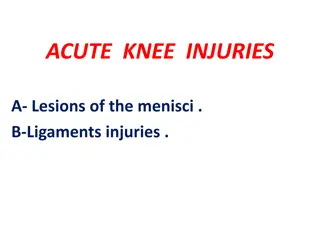Manual Handling Toolbox Talk - Importance and Prevention of Injuries
Manual handling injuries are a prevalent issue in workplaces, leading to significant work-related musculoskeletal disorders. Employers must assess and mitigate risks associated with manual handling to ensure employee safety and well-being. Employees also have responsibilities to follow safety protocols and report hazardous activities. Automation and mechanization should be considered to avoid manual handling where possible, reducing the likelihood of injuries and promoting a safer work environment.
Download Presentation

Please find below an Image/Link to download the presentation.
The content on the website is provided AS IS for your information and personal use only. It may not be sold, licensed, or shared on other websites without obtaining consent from the author. Download presentation by click this link. If you encounter any issues during the download, it is possible that the publisher has removed the file from their server.
E N D
Presentation Transcript
Manual Handling Tool Box Talk
Manual Handling What s the problem? More than a third of all over-three-day injuries reported each year to HSE and local authorities are caused by manual handling - the transporting or supporting of loads by hand or by bodily force. The most recent survey of self-reported work-related illness estimated that in 2001/02, 1.1 million people in Great Britain suffered from musculoskeletal disorders (MSDs) caused or made worse by their current or past work. An estimated 12.3 million working days were lost due to these work-related MSDs. On average each sufferer took about 20 days off in that 12-month period.
Manual handling injuries can occur wherever people are at work - on farms and building sites, in factories, offices, warehouses, hospitals, banks, laboratories, and while making deliveries. Heavy manual labour, awkward postures, manual materials handling, and previous or existing injury are all risk factors implicated in the development of MSDs. Prevention and control of MSDs, such as manual handling injuries, has been identified as a priority by the Health and Safety Commission. Taking the action described in this booklet will help prevent these injuries and is likely to be cost effective. However you cannot prevent all MSDs, so it is still essential to encourage early reporting of symptoms and make arrangements for the proper treatment and rehabilitation of anybody who does get injured. The Regulations require employers to: avoid the need for hazardous manual handling, so far as is reasonably practicable; assess the risk of injury from any hazardous manual handling that can t be avoided; and reduce the risk of injury from hazardous manual handling, so far as is reasonably practicable.
Employees have duties too. They should: follow appropriate systems of work laid down for their safety; make proper use of equipment provided for their safety; co-operate with their employer on health and safety matters; inform the employer if they identify hazardous handling activities; take care to ensure that their activities do not put others at risk.
Avoiding manual handling Check whether you need to move it at all For example: does a large work piece really need to be moved, or can the activity (eg wrapping or machining) safely be done where the item already is? Consider automation, particularly for new processes Think about mechanisation and using handling aids For example: a conveyor; a pallet truck; an electric or hand-powered hoist; a lift truck. But beware of new hazards from automation or mechanisation.
Also Consider the following: The tasks, do they involve: holding loads away from the body? twisting, stooping or reaching upwards? large vertical movement? long carrying distances? strenuous pushing or pulling? repetitive handling? insufficient rest or recovery time? a work rate imposed by a process? Can you: use a lifting aid? reduce the amount of twisting and stooping? improve workplace layout to improve efficiency? avoid lifting from floor level or above shoulder height, especially heavy loads? reduce carrying distances? avoid repetitive handling? vary the work, allowing one set of muscles to rest while another is used?
The loads, are they: heavy, bulky or unwieldy? difficult to grasp? unstable or likely to move unpredictably (like animals)? harmful, eg sharp or hot? awkwardly stacked? too large for the handler to see over? Can you make the load: lighter or less bulky? easier to grasp? more stable? less damaging to hold? If the load comes in from elsewhere, have you asked the supplier to help, eg provide handles or smaller packages?
The working environment, are there: constraints on posture? bumpy, obstructed or slippery floors? variations in levels? hot/cold/humid conditions? gusts of wind or other strong air movements? poor lighting conditions? restrictions on movements or posture from clothes or personal protective equipment PPE)? Can you: provide better flooring? remove obstructions to free movement? provide better flooring? avoid steps and steep ramps? prevent extremes of hot and cold? improve lighting? provide protective clothing or PPE that is less restrictive? ensure your employees clothing and footwear is suitable for their work?
Individual capacity, does the job: require unusual capability, eg above-average strength or agility? endanger those with a health problem or learning/physical disability? endanger pregnant women? call for special information or training? Can you: pay particular attention to those who have a physical weakness? take extra care of pregnant workers? give your employees more information, eg about the range of tasks they are likely to face? provide more training (see What about training? ) Get advice from an occupational health advisor if you need to.
Handling aids and equipment: is the device the correct type for the job? is it well maintained? are the wheels on the device suited to the floor surface? do the wheels run freely? is the handle height between the waist and shoulders? are the handle grips in good order and comfortable? are there any brakes? If so, do they work? Can you: provide equipment that is more suitable for the task? carry out planned preventive maintenance to prevent problems? change the wheels, tyres and/or flooring so that equipment moves easily? provide better handles and handle grips? make the brakes easier to use, reliable and effective?
Work organisation factors: is the work repetitive or boring? is work machine or system-paced? do workers feel the demands of the work are excessive? have workers little control of the work and working methods? is there poor communication between managers and employees? Can you: change tasks to reduce the monotony? make more use of workers skills? make workloads and deadlines more achievable? encourage good communication and teamwork? involve workers in decisions? provide better training and information?
Good handling technique for lifting Here are some practical tips, suitable for use in training people in safe manual handling. In the following section a basic lifting operation is taken as an example. Think before lifting/handling. Plan the lift. Can handling aids be used? Where is the load going to be placed? Will help be needed with the load? Remove obstructions such as discarded wrapping materials. For a long lift, consider resting the load midway on a table or bench to change grip. Keep the load close to the waist. Keep the load close to the body for as long as possible while lifting. Keep the heaviest side of the load next to the body. If a close approach to the load is not possible, try to slide it towards the body before attempting to lift it. Adopt a stable position. The feet should be apart with one leg slightly forward to maintain balance (alongside the load, if it is on the ground). The worker should be prepared to move their feet during the lift to maintain their stability.
Adopt a stable position Avoid tight clothing or unsuitable footwear, which may make this difficult. with feet apart and one Get a good hold. Where possible the load should be hugged as close as leg slightly forward to possible to the body. This may be better than gripping it tightly with hands only. maintain balance Start in a good posture. At the start of the lift, slight bending of the back, hips and knees is preferable to fully flexing the back (stooping) or fully flexing the hips and knees (squatting). Don t flex the back any further while lifting. This can happen if the legs begin to straighten before starting to raise the load. Avoid twisting the back or leaning sideways, especially while the back is bent. Shoulders should be kept level and facing in the same direction as the hips. Turning by moving the feet is better than twisting and lifting at the same time. Keep the head up when handling. Look ahead, not down at the load, once it has been held securely. Move smoothly. The load should not be jerked or snatched as this can make it harder to keep control and can increase the risk of injury. Start in a good posture Don t lift or handle more than can be easily managed. There is a difference between what people can lift and what they can safely lift. If in doubt, seek advice or get help. Put down, then adjust. If precise positioning of the load is necessary, put it down first, then slide it into the desired position.
Good handling technique for pushing and pulling Here are some practical points to remember when loads are pushed or pulled. Handling devices. Aids such as barrows and trolleys should have handle heights that are between the shoulder and waist. Devices should be well maintained with wheels that run smoothly (the law requires that equipment is maintained). When purchasing new trolleys etc, ensure they are of good quality with large diameter wheels made of suitable material and with castors, bearings etc which will last with minimum maintenance. Consultation with your employees and safety representatives will help, as they know what works and what doesn t. Force. As a rough guide the amount of force that needs to be applied to move a load over a flat, level surface using a well-maintained handling aid is at least 2% of the load weight. For example, if the load weight is 400 kg, then the force needed to move the load is 8 kg. The force needed will be larger, perhaps a lot larger, if conditions are not perfect (eg wheels not in the right position or a device that is poorly maintained). The operator should try to push rather than pull when moving a load, provided they can see over it and control steering and stopping.
Slopes. Employees should enlist help from another worker whenever necessary if they have to negotiate a slope or ramp, as pushing and pulling forces can be very high. For example, if a load of 400 kg is moved up a slope of 1 in 12 (about 5o), the required force is over 30 kg even in ideal conditions good wheels and a smooth slope. This is above the guideline weight for men and well above the guideline weight for women. Uneven surfaces. Moving an object over soft or uneven surfaces requires higher forces. On an uneven surface, the force needed to start the load moving could increase to 10% of the load weight, although this might be offset to some extent by using larger wheels. Soft ground may be even worse. Stance and pace. To make it easier to push or pull, employees should keep their feet well away from the load and go no faster than walking speed. This will stop them becoming too tired too quickly.
Declaration Manual Handling Training I .. confirm that I am a competent at following the correct procedure for manual handling. I have read and understand the instructions given to me on _______________ with regards to manual handling and can confirm I agree to their instructions. In the event that I am involved in an accident involving manual handling, or in fact any accident at work, I understand that it is my duty to inform the Health and Safety Manager immediately both verbally and in writing thereafter. Signed: __________________________________________ Print: _____________________________________________ Date: ___________________________





























